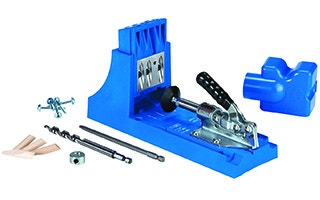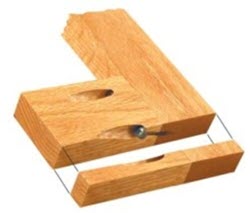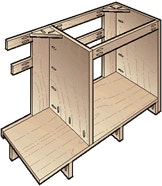Pocket Hole Joinery with the Kreg Jig

Pocket hole joinery isn't new. The speed and reliability of the technique have made it a favorite in furniture manufacturing and cabinet shops for decades. But for the small shop and weekend woodworker, pocket hole joinery took a giant leap forward in 1990, when Craig Sommerfield brought out the first commercially available model of his remarkable Kreg Jig. Since its introduction, the Kreg Jig has lead the way in affordable, easy to use pocket hole joinery systems.
Today there's a whole range of Kreg Jig packages, from ultra-affordable kits with just the most important features to the most complete system you're likely to find anywhere - the Kreg K3 Master System. And Rockler Woodworking and Hardware makes it easy to find just the tool you're looking for with our broad selection of Kreg pocket hole joinery systems accessories and supplies.
What is pocket hole joinery?
Pocket hole joinery is a very simple process - it involves nothing more than drilling an angled counterbore into a piece of wood and joining it to another piece of wood with a screw. The bottom of the counterbore (the "pocket hole") sits about 1/2' back from the edge being joined and provides room for the head of the screw. The clearance hole aims the screw at a sharp angle so that it can take a solid hold the adjoining material without popping up through the surface of the wood.

Easy enough - but how do you consistently and accurately drill a counterbore and pilot hole at such a steep angle? Craig Sommerfield's simple solution was to design a jig with metal drill guides pre-set to the best angle and entry point for a pocket hole, and to make it quick and easy to get the jig positioned and clamped onto a workpiece in just the right spot. With the jig in place, a stepped drill bit drills the counter bore and pilot hole in one shot. With the self-tapping screws the system uses, there's no need to drill a pilot hole. Pocket hole joinery with the Kreg system a fast and simple 2-step process: drill a hole, and screw the parts together. The real beauty of the Kreg pocket hole joinery system is that it allows you to securely and permanently join materials without the precision milling operations required by other techniques. Traditional joinery methods usually involve milling both parts of the joint - cutting a mortise and a tenon, for example. Apart from adding an extra step, that almost always means both parts have to be cut with extreme accuracy so they'll line up properly when the joint is assembled. With the Kreg system, there's no complicated set-up, measuring, or dry-fitting joints. In short, if you can operate a drill, you can make a perfect pocket hole joint in a matter of minutes.
What About Strength?
The steel self-tapping screws the Kreg system uses are much stronger than the wood fasteners they replace - dowels, tenons, biscuits, etc. Along with that, the self tapping screws exert a tremendous amount of clamping pressure, drawing the surfaces of the wood into the "intimate contact" that adhesive manufacturers say is among the most important factors in producing a solid glue joint. Finally, the highly compressed screws stay in the workpiece permanently; it's like being able to leave your project clamped solidly together - forever. The superior strength of a pocket hole joint has actually been proven. Independent testing found that a pocket screw joint failed at 707 pounds when subjected to a shear load while a comparable mortise and tenon joint failed at 453 pounds - meaning that the pocket screw joint was approximately 35% stronger.
What Joints Can You Make with the Kreg System?

The Kreg Pocket Hole Joinery System earned its fame as a cabinet making tool -- there's really no better method for joining the stiles and rails of a face frame. And pocket hole joinery is becoming an increasingly popular method for joining the members of cabinet carcases, and for joining carcases to face frames.
But pocket hole joinery isn't just for cabinet making. Simply stated, pocket hole joinery is one of the best methods for joining any two pieces of wood where a strong joint with no visible fasteners on one surface is the order of business. As the manufacturer of the Kreg jig puts it, the uses for pocket hole joinery are only limited by the users imagination.
Pocket hole joinery suggestions from Kreg, to help you start thinking "outside the box."

Cabinet frames, face frames and carcases are among the most popular applications for pocket hole joinery.


Leg Rails and Braces - Securely attach leg rails and braces quickly and invisibly.

Stairs - Attach risers and treads to each other and to stair stringers from underneath. High compression pocket hole joints will give you squeak-free stairs every time and you won't have to set a single nail.

Edging - Pocket hole joinery pulls edging up tight against table tops and countertops - and keeps it there.

Picture Frames - Pocket hole joinery gives you exceptionally tight mitered picture frame joints without difficult corner-clamping.

Jambs - Add extension jamb to a window or door without visible fasteners. Pocket hole joints keep jambs in place and provide a tight, weather-sealed seam.

Curves - Ever try to clamp a curve? Pocket hole joinery makes it easy to assemble odd-angled parts and gives curved forms extra rigidity.

Decks - Attach outdoor decking, rails and balusters with pocket hole joinery. Rockler offers weather-treated screws from Kreg made just for the purpose.
We hope that gives you an idea of the versatility of pocket hole joinery. We're sure you'll come up with a few ideas of your own. One thing is certain, you won't find a faster or more durable method for joining wood than pocket hole joinery, and you won't find a better designed system for getting the job done than the Kreg Jig.
Keep the inspiration coming!
Subscribe to our newsletter for more woodworking tips and tricks

